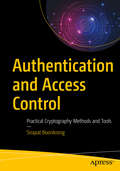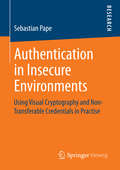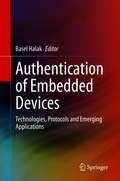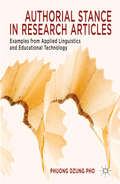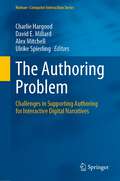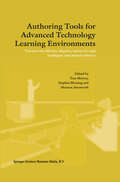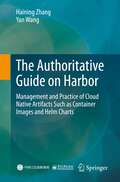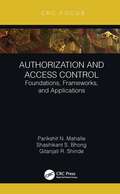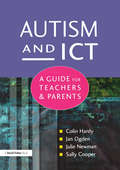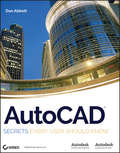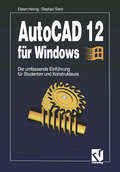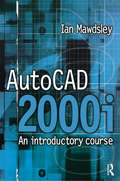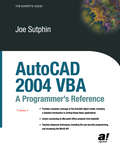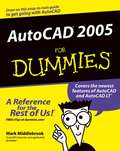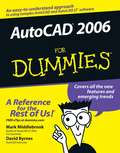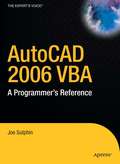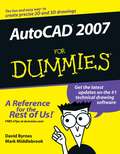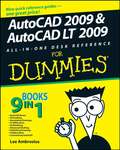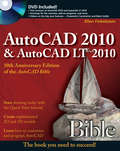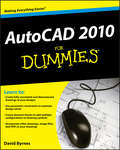- Table View
- List View
Authentication and Access Control: Practical Cryptography Methods and Tools
by Sirapat BoonkrongCybersecurity is a critical concern for individuals and for organizations of all types and sizes. Authentication and access control are the first line of defense to help protect you from being attacked. This book begins with the theoretical background of cryptography and the foundations of authentication technologies and attack mechanisms. You will learn about the mechanisms that are available to protect computer networks, systems, applications, and general digital technologies.Different methods of authentication are covered, including the most commonly used schemes in password protection: two-factor authentication and multi-factor authentication. You will learn how to securely store passwords to reduce the risk of compromise. Biometric authentication—a mechanism that has gained popularity over recent years—is covered, including its strengths and weaknesses. Authentication and Access Control explains the types of errors that lead to vulnerabilities in authentication mechanisms. To avoid these mistakes, the book explains the essential principles for designing and implementing authentication schemes you can use in real-world situations. Current and future trends in authentication technologies are reviewed. What You Will Learn Understand the basic principles of cryptography before digging into the details of authentication mechanismsBe familiar with the theories behind password generation and the different types of passwords, including graphical and grid-based passwordsBe aware of the problems associated with the use of biometrics, especially with establishing a suitable level of biometric matching or the biometric threshold valueStudy examples of multi-factor authentication protocols and be clear on the principlesKnow how to establish authentication and how key establishment processes work together despite their differencesBe well versed on the current standards for interoperability and compatibilityConsider future authentication technologies to solve today's problems Who This Book Is For Cybersecurity practitioners and professionals, researchers, and lecturers, as well as undergraduate and postgraduate students looking for supplementary information to expand their knowledge on authentication mechanisms
Authentication in Insecure Environments: Using Visual Cryptography and Non-Transferable Credentials in Practise
by Sebastian PapeSebastian Pape discusses two different scenarios for authentication. On the one hand, users cannot trust their devices and nevertheless want to be able to do secure authentication. On the other hand, users may not want to be tracked while their service provider does not want them to share their credentials. Many users may not be able to determine whether their device is trustworthy, i.e. it might contain malware. One solution is to use visual cryptography for authentication. The author generalizes this concept to human decipherable encryption schemes and establishes a relationship to CAPTCHAS. He proposes a new security model and presents the first visual encryption scheme which makes use of noise to complicate the adversary's task. To prevent service providers from keeping their users under surveillance, anonymous credentials may be used. However, sometimes it is desirable to prevent the users from sharing their credentials. The author compares existing approaches based on non-transferable anonymous credentials and proposes an approach which combines biometrics and smartcards.
Authentication of Embedded Devices: Technologies, Protocols and Emerging Applications
by Basel HalakThis book provides comprehensive coverage of state-of-the-art integrated circuit authentication techniques, including technologies, protocols and emerging applications.The authors first discuss emerging solutions for embedding unforgeable identifies into electronics devices, using techniques such as IC fingerprinting, physically unclonable functions and voltage-over-scaling. Coverage then turns to authentications protocols, with a special focus on resource-constrained devices, first giving an overview of the limitation of existing solutions and then presenting a number of new protocols, which provide better physical security and lower energy dissipation. The third part of the book focuses on emerging security applications for authentication schemes, including securing hardware supply chains, hardware-based device attestation and GPS spoofing attack detection and survival.Provides deep insight into the security threats undermining existing integrated circuit authentication techniques;Includes an in-depth discussion of the emerging technologies used to embed unforgeable identifies into electronics systems;Offers a comprehensive summary of existing authentication protocols and their limitations;Describes state-of-the-art authentication protocols that provide better physical security and more efficient energy consumption;Includes detailed case studies on the emerging applications of IC authentication schemes.
Authorial Stance in Research Articles: Examples from Applied Linguistics and Educational Technology
by P. PhoHow do I structure a journal article?; "Can I use 'I' in a research article?"; "Should I use an active or passive voice?" - Many such questions will be answered in this book, which documents the linguistic devices that authors use to show how they align or distance themselves from arguments and ideas, while maintaining conventions of objectivity.
The Authoring Problem: Challenges in Supporting Authoring for Interactive Digital Narratives (Human–Computer Interaction Series)
by Charlie Hargood David E. Millard Alex Mitchell Ulrike SpierlingAuthoring, its tools, processes, and design challenges are key issues for the Interactive Digital Narrative (IDN) research community. The complexity of IDN authoring, often involving stories co-created by procedures and user interaction, creates confusion for tool developers and raises barriers for new authors.This book examines these issues from both the tool designer and the author’s perspective, discusses the poetics of IDN and how that can be used to design authoring tools, explores diverse forms of IDN and their demands, and investigates the challenges around conducting research on IDN authoring.To address these challenges, the chapter authors incorporate a range of interdisciplinary perspectives on ‘The Authoring Problem’ in IDN. While existing texts provide ‘how-to’ guidance for authors, this book is a primer for research and practice-based investigations into the authoring problem, collecting the latest thoughts about this area from key researchers and practitioners.
Authoring Tools for Advanced Technology Learning Environments: Toward Cost-Effective Adaptive, Interactive and Intelligent Educational Software
by T. Murray S. Blessing S. AinsworthThis edited book gives a comprehensive picture of the state of the art in authoring systems and authoring tools for advanced technology instructional systems. It includes descriptions of fifteen systems and research projects from almost every significant effort in the field. The book will appeal to researchers, teachers and advanced students working in education, instructional technology and computer-based education, psychology, cognitive science and computer science.
The Authoritative Guide on Harbor: Management and Practice of Cloud Native Artifacts Such as Container Images and Helm Charts
by Haining Zhang Yan WangHarbor is a major CNCF open source project, with thousands of production users all over the world. This book provides a comprehensive explanation of the open source cloud native registry: Harbor. Written by experts who contributed to and now maintain Harbor, the content covers its architecture, principles, functions, deployment and configuration, scanning artifacts, remote replication, operation and maintenance, customized development, API usage and success stories. The book offers a valuable guide for Harbor users, developers and contributors, cloud native software development engineers, test engineers, operational and maintenance engineers, IT architects and IT technical managers. It will also benefit university students in computer-related disciplines.
Authorization and Access Control: Foundations, Frameworks, and Applications
by Parikshit N. Mahalle Shashikant S. Bhong Gitanjali R. ShindeThis book focuses on various authorization and access control techniques, threats and attack modeling, including an overview of the Open Authorization 2.0 (OAuth 2.0) framework along with user-managed access (UMA) and security analysis. Important key concepts are discussed regarding login credentials with restricted access to third parties with a primary account as a resource server. A detailed protocol overview and authorization process, along with security analysis of OAuth 2.0, are also discussed in the book. Case studies of websites with vulnerability issues are included. FEATURES Provides an overview of the security challenges of IoT and mitigation techniques with a focus on authorization and access control mechanisms Discusses a behavioral analysis of threats and attacks using UML base modeling Covers the use of the OAuth 2.0 Protocol and UMA for connecting web applications Includes role-based access control (RBAC), discretionary access control (DAC), mandatory access control (MAC) and permission-based access control (PBAC) Explores how to provide access to third-party web applications through a resource server by use of a secured and reliable OAuth 2.0 framework This book is for researchers and professionals who are engaged in IT security, auditing and computer engineering.
Authorization and Access Control: Foundations, Frameworks, and Applications
by Parikshit N. Mahalle Shashikant S. Bhong Gitanjali R. ShindeThis book focuses on various authorization and access control techniques, threats and attack modeling, including an overview of the Open Authorization 2.0 (OAuth 2.0) framework along with user-managed access (UMA) and security analysis. Important key concepts are discussed regarding login credentials with restricted access to third parties with a primary account as a resource server. A detailed protocol overview and authorization process, along with security analysis of OAuth 2.0, are also discussed in the book. Case studies of websites with vulnerability issues are included. FEATURES Provides an overview of the security challenges of IoT and mitigation techniques with a focus on authorization and access control mechanisms Discusses a behavioral analysis of threats and attacks using UML base modeling Covers the use of the OAuth 2.0 Protocol and UMA for connecting web applications Includes role-based access control (RBAC), discretionary access control (DAC), mandatory access control (MAC) and permission-based access control (PBAC) Explores how to provide access to third-party web applications through a resource server by use of a secured and reliable OAuth 2.0 framework This book is for researchers and professionals who are engaged in IT security, auditing and computer engineering.
Autism and ICT: A Guide for Teachers and Parents
by Julie Newman Sally Cooper Colin Hardy Jan OgdenThis book offers a practical approach for staff and carers who want to develop the use of ICT for children on the autistic spectrum and for those with language and communication difficulties. It combines descriptions of current research and literature on the subject of autism and ICT with practical guidance on software and hardware. A practical approach encourages experimentation, values the skills and attributes that participants bring and minimizes the technical barrier to ICT use. It includes concise information on what autism is, and examples of a range of pupils and their typical learning behaviors. It offers advice on how ICT can relate to various aspects of autism, information on concept keyboards and touch-sensitive screens and switches, and help with buying a computer and using the internet. Teachers, carers and parents of children with autism or language and communication problems will find lots of useful suggestions and advice on how to use ICT to help access the curriculum.
Autism and ICT: A Guide for Teachers and Parents
by Julie Newman Sally Cooper Colin Hardy Jan OgdenThis book offers a practical approach for staff and carers who want to develop the use of ICT for children on the autistic spectrum and for those with language and communication difficulties. It combines descriptions of current research and literature on the subject of autism and ICT with practical guidance on software and hardware. A practical approach encourages experimentation, values the skills and attributes that participants bring and minimizes the technical barrier to ICT use. It includes concise information on what autism is, and examples of a range of pupils and their typical learning behaviors. It offers advice on how ICT can relate to various aspects of autism, information on concept keyboards and touch-sensitive screens and switches, and help with buying a computer and using the internet. Teachers, carers and parents of children with autism or language and communication problems will find lots of useful suggestions and advice on how to use ICT to help access the curriculum.
AutoCAD: Secrets Every User Should Know
by Dan Abbott"I've been using AutoCAD for 22 years and have written a hundred books on the subject. I reviewed many CAD books back in the days when book reviews were common in CAD publications; some were innovative, others were just sad. But for nearly a decade, it's been mostly silence on the book review front. Then earlier in the summer, a book arrived in the mail from Sybex: AutoCAD Secrets Every User Should Know by Dan Abbott. Reading it, I got excited: here's a book for every AutoCAD user, even old-timers like me." - Ralph Grabowski, Editor, upFront.eZine.com: The Business of CAD Learn the "why" behind the "how" in this one-of-a-kind reference packed with tips and techniques from award-winning AutoCAD expert Dan Abbott. This info-packed guide reveals some of the best kept AutoCAD secrets on technical standards, AutoLISP programming, DOS functions, scripts, 3D, and everything in between. Based on his popular "Things Every AutoCAD User Should Know" session at Autodesk University and other industry events, Dan gives you the answers to frequently asked AutoCAD questions in his direct and entertaining style while using real-world case studies to put your skills into practice. Read it cover to cover or dive right in to the sections you need most, then get ready to improve your productivity, save more time, and become an AutoCAD all-star.
AutoCAD 2000i: An Introductory Course
by Ian MawdsleyThe step-by-step instructions and clear explanations make the book ideal for courses with limited contact time, and for independent study. Numerous exercises throughout enable students to develop their own CAD skills as well as reinforcing their understanding of AutoCAD commands.Ian Mawdsley has drawn on his own extensive teaching experience to produce material for use in a CAD suite where the lecturer will be supporting a number of students who are progressing at different rates. His book is the only AutoCAD resource available written with a real understanding of teaching requirements - a breath of fresh air for lecturers who have been working with hefty application manuals or superficial software guides. This book has been carefully designed to meet the needs of AutoCAD courses run by universities, colleges and an increasing number of schools. Anyone who completes Ian Mawdsley's course will have gained a thorough grounding in 2D techniques and explored the basics of 3D work. The content of the course covers the requirements of the new City & Guilds 4351 scheme and the new Edexcel Advanced Award in AutoCAD (level 3).
AutoCAD 2000i: An Introductory Course
by Ian MawdsleyThe step-by-step instructions and clear explanations make the book ideal for courses with limited contact time, and for independent study. Numerous exercises throughout enable students to develop their own CAD skills as well as reinforcing their understanding of AutoCAD commands.Ian Mawdsley has drawn on his own extensive teaching experience to produce material for use in a CAD suite where the lecturer will be supporting a number of students who are progressing at different rates. His book is the only AutoCAD resource available written with a real understanding of teaching requirements - a breath of fresh air for lecturers who have been working with hefty application manuals or superficial software guides. This book has been carefully designed to meet the needs of AutoCAD courses run by universities, colleges and an increasing number of schools. Anyone who completes Ian Mawdsley's course will have gained a thorough grounding in 2D techniques and explored the basics of 3D work. The content of the course covers the requirements of the new City & Guilds 4351 scheme and the new Edexcel Advanced Award in AutoCAD (level 3).
AutoCAD 2004 VBA: A Programmer's Reference
by Joe Sutphin* Major update of Sutphin’s successful AutoCAD 2000 Programmer’s Reference. * Introduction to Visual Basic allows use by experienced AutoCAD developers who are new to programming. * Comprehensive coverage of the AutoCAD object model. * New coverage of AutoCAD 2000 features including file and security programming, customizing the IDE and accessing the Win32 API.
AutoCAD 2005 For Dummies
by Mark MiddlebrookShows how to use the leading technical drawing software-AutoCAD-and its less-expensive sister product, AutoCAD LT, in the friendly, easy-to-understand For Dummies style Shows first-time AutoCAD users how to create precise and efficient 2-D technical drawings and get started with 3-D technical drawings Topics covered include creating a basic layout; drawing and editing; writing text in drawings; plotting, creating, and editing external reference files; CAD standards; and drawing on the Internet Explores new features in the latest version of AutoCAD, including text improvements, streamlined Plot and Page Setup dialogue boxes, increased emphasis on tool palettes, better tools for transmitting sets of electronic files, and much more Includes a new chapter on sheet sets and a new collection of features for creating, managing, and publishing all of the drawings that make up a project
AutoCAD 2006 For Dummies
by Mark Middlebrook David ByrnesAutoCAD "X" For Dummies is being updated to reflect the new features in the latest release of AutoCAD.
AutoCAD 2006 VBA: A Programmer's Reference
by Joe Sutphin* Second Edition of the comprehensive and highly respected guide to the AutoCAD VBA language. * Suitable for all skill levels, novice and advanced power users. * A complete reference for the AutoCAD 2006 object model, it shows you how to connect to other VBA-enabled applications, such as Word and Excel, and use the using the Win32 API to further extend your applications.
AutoCAD 2007 For Dummies
by David Byrnes Mark MiddlebrookAutoCAD 2007 is a premiere computer-aided designing program that lets you organize the objects you draw, their properties, and their files. It also helps you create great-looking models. But it’s not always easy to figure out how to perform these functions, and many users end up missing out on AutoCAD’s full potential. AutoCAD 2007 For Dummies will show you how to perform these tasks and more! This hands-on guide lets you discover how to navigate around all the complications and start creating cool drawings in no time. Soon you’ll have the tools you need to use DWG, set up drawings, add text, and work with lines, as well as: Draw a base plate with rectangles and circles Organize a successful template Zoom and pan with glass and hand Use the AutoCAD design center Navigate through your 3-D drawing projects Plot layout, lineweights, and colors Design block definitions Slice and dice your drawings to create new designs Create a Web format using AutoCAD This book also features suggestions and tips on how to touch up your creations as well as ways to swap drawing data with other people and programs. Written in a friendly, straightforward tone that doesn’t try to overwhelm you, AutoCAD 2007 For Dummies shows you the fun and easy way to draw precise 2-D and 3-D drawings!
AutoCAD 2007 For Dummies
by David Byrnes Mark MiddlebrookAutoCAD 2007 is a premiere computer-aided designing program that lets you organize the objects you draw, their properties, and their files. It also helps you create great-looking models. But it’s not always easy to figure out how to perform these functions, and many users end up missing out on AutoCAD’s full potential. AutoCAD 2007 For Dummies will show you how to perform these tasks and more! This hands-on guide lets you discover how to navigate around all the complications and start creating cool drawings in no time. Soon you’ll have the tools you need to use DWG, set up drawings, add text, and work with lines, as well as: Draw a base plate with rectangles and circles Organize a successful template Zoom and pan with glass and hand Use the AutoCAD design center Navigate through your 3-D drawing projects Plot layout, lineweights, and colors Design block definitions Slice and dice your drawings to create new designs Create a Web format using AutoCAD This book also features suggestions and tips on how to touch up your creations as well as ways to swap drawing data with other people and programs. Written in a friendly, straightforward tone that doesn’t try to overwhelm you, AutoCAD 2007 For Dummies shows you the fun and easy way to draw precise 2-D and 3-D drawings!
AutoCAD 2009 and AutoCAD LT 2009 All-in-One Desk Reference For Dummies
by Lee AmbrosiusNobody ever said AutoCAD was easy, which is why you need AutoCAD & AutoCAD LT 2009 All-In-One Desk Reference for Dummies! These nine minibooks cover all the stuff you need to know to set up AutoCAD for 2D or 3D, create drawings, modify and share them, publish your work, and more. There’s even a minibook devoted to increasing your options with AutoCAD LT! This one-stop guide to creating great technical drawings using AutoCAD 2009 shows you how to navigate the AutoCAD interface, set up drawings, use basic and precision tools, and use drawing objects. You’ll learn how to annotate your drawings, use dimensioning and hatching, and work with AutoCAD’s new Annotation Scaling feature. You’ll also find out how to work with solids, texture surfaces, add lighting, and much more. Discover how to Navigate the AutoCAD interface Work with lines, shapes, and curves Add explanatory text Understand AutoCAD LT’s limitations Render your drawings Create and manage blocks Use AutoCAD advanced drafting techniques Comply with CAD management and standards Share your work with others Customize the AutoCAD interface, tools, and more Complete with Web links to advanced information on navigating the AutoCAD programming interfaces, using custom programs, getting started with AutoLISP, and working with Visual Basic for AutoCAD, AutoCAD & AutoCAD LT 2009 All-In-One Desk Reference for Dummies is the only comprehensive AutoCAD guide you’ll ever need.
AutoCAD 2010 and AutoCAD LT 2010 Bible (Bible #572)
by Ellen Finkelstein10th anniversary edition of the bestselling AutoCAD Bible Even AutoCAD developers turn to this book for answers! Find out what fans of all the previous bestselling editions of this book already know: this is the top all-in-one guide to everything you need to master AutoCAD. Whether you're a novice looking to start with the basics and progress to programming, or an AutoCAD veteran exploring what's new or seeking a quick refresher, every feature is covered. Start drawing today in AutoCAD 2010 with the one book you need to succeed. Start drawing right away with a Quick Start project Draw, view, and edit in 2D, then add text and dimensions Reference other drawings and link data to objects Build, view, and present complex 3D drawings Customize commands, create shortcuts, and use scripts and macros Program AutoCAD using AutoLISP® and VBA What's on the DVD? Trial versions of both AutoCAD 2010 and AutoCAD LT 2010 Over 300 before-and-after drawings from working AutoCAD professionals A selection of helpful add-on programs The entire book in searchable PDF Videos on the two big new features of AutoCAD 2010— Parametric Constraints and Mesh Solids System Requirements: Please see the DVD appendix for details and system requirements. Control your drawings with the new parametric constraints Draw and display sophisticated 2D and 3D models Create organic, molded solids with 3D meshes Note: CD-ROM/DVD and other supplementary materials are not included as part of eBook file.
AutoCAD 2010 and AutoCAD LT 2010 Bible (Bible #572)
by Ellen Finkelstein10th anniversary edition of the bestselling AutoCAD Bible Even AutoCAD developers turn to this book for answers! Find out what fans of all the previous bestselling editions of this book already know: this is the top all-in-one guide to everything you need to master AutoCAD. Whether you're a novice looking to start with the basics and progress to programming, or an AutoCAD veteran exploring what's new or seeking a quick refresher, every feature is covered. Start drawing today in AutoCAD 2010 with the one book you need to succeed. Start drawing right away with a Quick Start project Draw, view, and edit in 2D, then add text and dimensions Reference other drawings and link data to objects Build, view, and present complex 3D drawings Customize commands, create shortcuts, and use scripts and macros Program AutoCAD using AutoLISP® and VBA What's on the DVD? Trial versions of both AutoCAD 2010 and AutoCAD LT 2010 Over 300 before-and-after drawings from working AutoCAD professionals A selection of helpful add-on programs The entire book in searchable PDF Videos on the two big new features of AutoCAD 2010— Parametric Constraints and Mesh Solids System Requirements: Please see the DVD appendix for details and system requirements. Control your drawings with the new parametric constraints Draw and display sophisticated 2D and 3D models Create organic, molded solids with 3D meshes Note: CD-ROM/DVD and other supplementary materials are not included as part of eBook file.
AutoCAD 2010 For Dummies
by David ByrnesAutoCAD is the hot computer-aided design software known for both its powerful tools and its complexity. AutoCAD 2010 for Dummies is the bestselling guide that walks you through this complicated program so you can build complex 3D technical drawings, edit like a pro, enter new dimensions, and plot with style. AutoCAD 2010 for Dummies helps you navigate the program, use the AutoCAD Design Center, create a basic layout and work with dimension, and put your drawings on the Internet. You’ll soon be setting up the AutoCAD environment, using the AutoCAD Ribbon, creating annotation and dimension drawings, exploring 3D models, and cruising comfortably through AutoCAD 2010. Understand object selection and learn all about commanding and selecting, one-by-one selection, and perfecting selecting Use the AutoCAD tool kit and learn to copy between drawings, manipulate images, and polish your properties Turn on your annotative objects and say more in multiline text Understand the anatomy of a dimension, then draw and edit your own Get up to speed on how to create block definitions, insert blocks, and more Discover techniques for setting up a layout in paper space Push the boundary of hatch and define hatch objects Learn to design in Web format and draw on the Internet With AutoCAD, the only limits are your imagination. AutoCAD 2010 for Dummies prepares you to use this powerful software to design and document your ideas in 2D and 3D.
